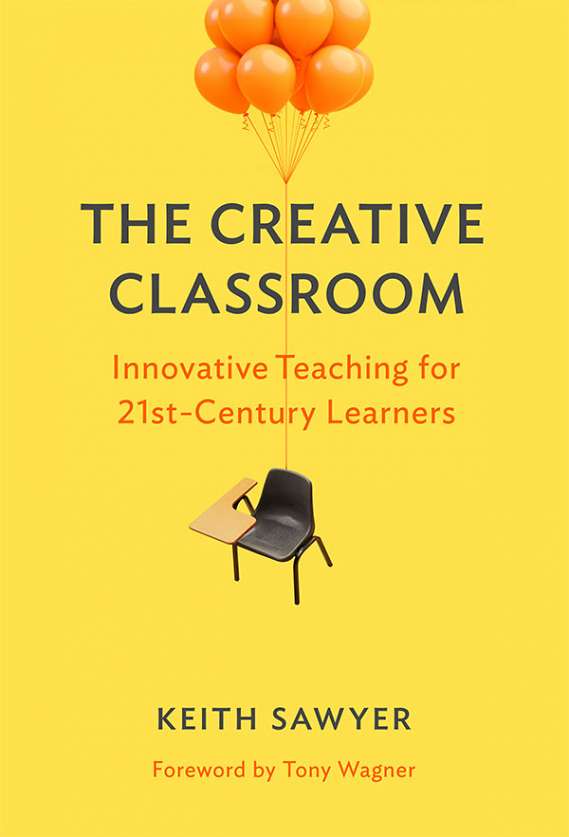Professors: Request an Exam Copy
Print copies available for US orders only. For orders outside the US, see our international distributors.
Foreword by: Tony Wagner
Publication Date: August 9, 2019
Pages: 128

The Creative Classroom presents an original, compelling vision of schools where teaching and learning are centered on creativity. Drawing on the latest research as well as his studies of jazz and improvised theater, Sawyer describes curricula and classroom practices that will help educators get started with a new style of teaching, guided improvisation, where students are given freedom to explore within structures provided by the teacher. Readers will learn how to improve learning outcomes in all subjects—from science and math to history and language arts—by helping students master content-area standards at the same time as they increase their creative potential. This book shows how teachers and school leaders can work together to overcome all-too-common barriers to creative teaching—leadership, structure, and culture—and collaborate to transform schools into creative organizations.
Book Features:
Keith Sawyer is the Morgan Distinguished Professor in Educational Innovations at the University of North Carolina at Chapel Hill.
“Those wishing to foster student creativity should consult Keith Sawyer’s The Creative Classroom.”
—The Wabash Center Journal on Teaching
“Professor Sawyer is one of the most innovative researchers on the topic of creativity, and his work will make it easier for educators and business executives to harness and develop the creative potential of the people around them—young or old.”
—Mihaly Csikszentmihalyi, Distinguished Professor of Psychology and Management and founder and codirector, Quality of Life Research Center, Claremont Graduate University
“As a leading learning scientist studying creativity, Keith Sawyer has now translated decades of research into an easy-to-use guide for deepening student creative knowledge and empowering teachers. This guide is important for all educators that are seeking to be in sync with the changing demands of the 21st century.”
—Kylie Peppler, associate professor of Learning Sciences, and director of the Creativity Labs, Indiana University Bloomington
“If you want to know why you should throw out your lecture notes and engage students actively in deeper learning, read this book. If you want to know how to engage students in deeper learning, read this book. Keith Sawyer has written a wise and judicious book that will challenge and inspire teachers at all levels and in all disciplines.”
—Ellen Winner, professor of psychology, Boston College and senior research associate, Project Zero, Harvard Graduate School of Education
“Keith Sawyer is a field leader in studies of creativity and education. He does not disappoint with this text on how to translate his years of research for teachers to understand how to create a classroom that is rich with arts-based pedagogy and creative expression. If teachers take one thing from this book, it’s to say 'Yes!' to kids’ voices.”
—Erica Halverson, School of Education, University of Wisconsin-Madison
Contents
Foreword Tony Wagner vii
Acknowledgments xi
1. Introduction 1
Teaching with Guided Improvisation 6
Facing the Teaching Paradox 8
The Creative Teachers of the Future 9
2. Teaching Creative Knowledge 11
Creative Knowledge and Shallow Knowledge 12
Moving Beyond the Coverage Trap 19
Learning Creativity and State Standards 22
Creative Habits of Mind 23
Creative Knowledge in Math, Science, and History 26
Teaching for Creativity in Every Subject 32
3. Guided Improvisation 35
Learning to Improvise 38
Collaboration and Improvisation 42
Improv Techniques for Teachers 44
When Teachers Need to Break the Rules 52
Lesson Planning for Guided Improvisation 53
Balancing Structure and Improvisation 54
Summary 55
4. Mastering the Teaching Paradox 57
The Structures of Guided Improvisation 59
Project-Based Learning and the Teaching Paradox 62
Managing the Teaching Paradox: Six Case Studies 65
From Novice Teacher to Expert Improviser 75
Improvising with Pedagogical Content Knowledge 77
Summary 79
5. Schools for Creativity 81
The Culture of the Creative School 82
Leadership in the Creative School 84
The Organizational Structure of the Creative School 86
Assessment in the Creative School 87
Summary 91
6. A Call to Action 93
References 98
Index 109
About the Author 116
Listen to Keith Sawyer’s podcast here
Professors: Request an Exam Copy
Print copies available for US orders only. For orders outside the US, see our international distributors.